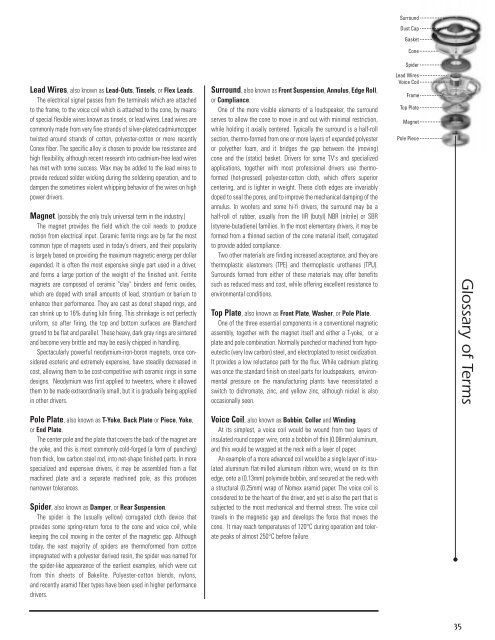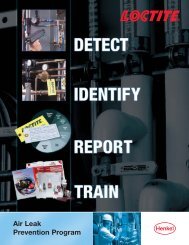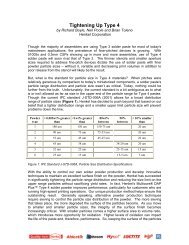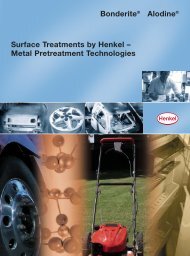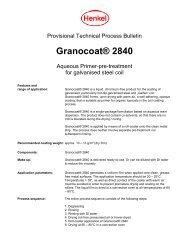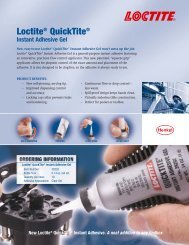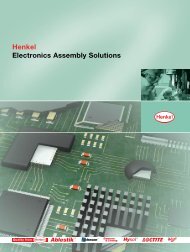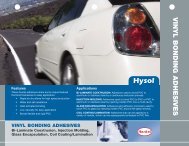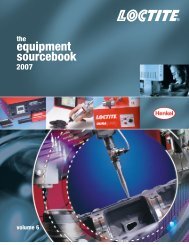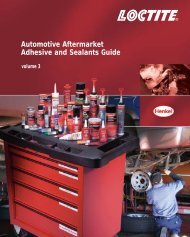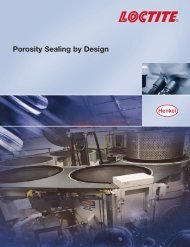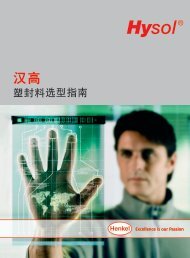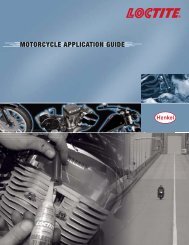SOUND ENGINEERING FROM - Loctite.ph
SOUND ENGINEERING FROM - Loctite.ph
SOUND ENGINEERING FROM - Loctite.ph
- No tags were found...
You also want an ePaper? Increase the reach of your titles
YUMPU automatically turns print PDFs into web optimized ePapers that Google loves.
SurroundDust CapGasketConeSpiderLead Wires, also known as Lead-Outs, Tinsels, or Flex Leads.The electrical signal passes from the terminals which are attachedto the frame, to the voice coil which is attached to the cone, by meansof special flexible wires known as tinsels, or lead wires. Lead wires arecommonly made from very fine strands of silver-plated cadmiumcoppertwisted around strands of cotton, polyester-cotton or more recentlyConex fiber. The specific alloy is chosen to provide low resistance andhigh flexibility, although recent research into cadmium-free lead wireshas met with some success. Wax may be added to the lead wires toprovide reduced solder wicking during the soldering operation, and todampen the sometimes violent whipping behavior of the wires on highpower drivers.Magnet. (possibly the only truly universal term in the industry.)The magnet provides the field which the coil needs to producemotion from electrical input. Ceramic ferrite rings are by far the mostcommon type of magnets used in today's drivers, and their popularityis largely based on providing the maximum magnetic energy per dollarexpended. It is often the most expensive single part used in a driver,and forms a large portion of the weight of the finished unit. Ferritemagnets are composed of ceramic "clay" binders and ferric oxides,which are doped with small amounts of lead, strontium or barium toenhance their performance. They are cast as donut shaped rings, andcan shrink up to 16% during kiln firing. This shrinkage is not perfectlyuniform, so after firing, the top and bottom surfaces are Blanchardground to be flat and parallel. These heavy, dark gray rings are sinteredand become very brittle and may be easily chipped in handling.Spectacularly powerful neodymium-iron-boron magnets, once consideredesoteric and extremely expensive, have steadily decreased incost, allowing them to be cost-competitive with ceramic rings in somedesigns. Neodymium was first applied to tweeters, where it allowedthem to be made extraordinarily small, but it is gradually being appliedin other drivers.Surround, also known as Front Suspension, Annulus, Edge Roll,or Compliance.One of the more visible elements of a loudspeaker, the surroundserves to allow the cone to move in and out with minimal restriction,while holding it axially centered. Typically the surround is a half-rollsection, thermo-formed from one or more layers of expanded polyesteror polyether foam, and it bridges the gap between the (moving)cone and the (static) basket. Drivers for some TV's and specializedapplications, together with most professional drivers use thermoformed(hot-pressed) polyester-cotton cloth, which offers superiorcentering, and is lighter in weight. These cloth edges are invariablydoped to seal the pores, and to improve the mechanical damping of theannulus. In woofers and some hi-fi drivers, the surround may be ahalf-roll of rubber, usually from the IIR (butyl) NBR (nitrile) or SBR(styrene-butadiene) families. In the most elementary drivers, it may beformed from a thinned section of the cone material itself, corrugatedto provide added compliance.Two other materials are finding increased acceptance, and they arethermoplastic elastomers (TPE) and thermoplastic urethanes (TPU).Surrounds formed from either of these materials may offer benefitssuch as reduced mass and cost, while offering excellent resistance toenvironmental conditions.Top Plate, also known as Front Plate, Washer, or Pole Plate.One of the three essential components in a conventional magneticassembly, together with the magnet itself and either a T-yoke, or aplate and pole combination. Normally punched or machined from hypoeutectic(very low carbon) steel, and electroplated to resist oxidization.It provides a low reluctance path for the flux. While cadmium platingwas once the standard finish on steel parts for loudspeakers, environmentalpressure on the manufacturing plants have necessitated aswitch to dichromate, zinc, and yellow zinc, although nickel is alsooccasionally seen.Lead WiresVoice CoilFrameTop PlateMagnetPole PieceGlossary of TermsPole Plate, also known as T-Yoke, Back Plate or Piece, Yoke,or End Plate.The center pole and the plate that covers the back of the magnet arethe yoke, and this is most commonly cold-forged (a form of punching)from thick, low carbon steel rod, into net-shape finished parts. In morespecialized and expensive drivers, it may be assembled from a flatmachined plate and a separate machined pole, as this producesnarrower tolerances.Spider, also known as Damper, or Rear Suspension.The spider is the (usually yellow) corrugated cloth device thatprovides some spring-return force to the cone and voice coil, whilekeeping the coil moving in the center of the magnetic gap. Althoughtoday, the vast majority of spiders are thermoformed from cottonimpregnated with a polyester derived resin, the spider was named forthe spider-like appearance of the earliest examples, which were cutfrom thin sheets of Bakelite. Polyester-cotton blends, nylons,and recently aramid fiber types have been used in higher performancedrivers.Voice Coil, also known as Bobbin, Collar and Winding.At its simplest, a voice coil would be wound from two layers ofinsulated round copper wire, onto a bobbin of thin (0.08mm) aluminum,and this would be wrapped at the neck with a layer of paper.An example of a more advanced coil would be a single layer of insulatedaluminum flat-milled aluminum ribbon wire, wound on its thinedge, onto a (0.13mm) polyimide bobbin, and secured at the neck witha structural (0.25mm) wrap of Nomex aramid paper. The voice coil isconsidered to be the heart of the driver, and yet is also the part that issubjected to the most mechanical and thermal stress. The voice coiltravels in the magnetic gap and develops the force that moves thecone. It may reach temperatures of 120°C during operation and toleratepeaks of almost 250°C before failure.35


